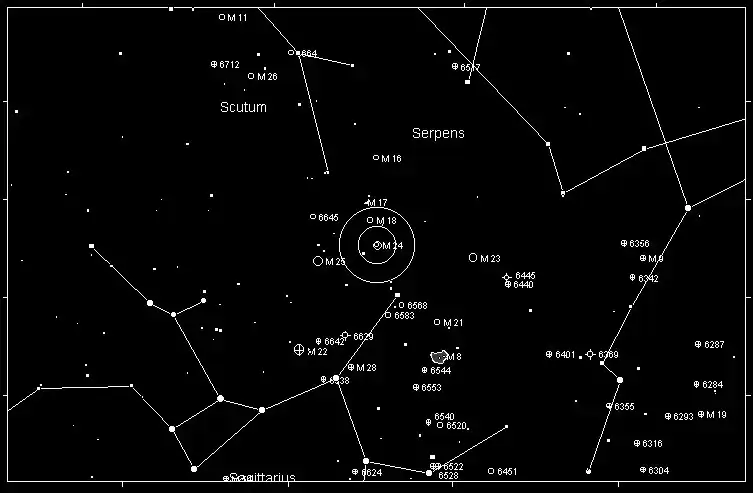Messier 24, also known as the Sagittarius Star Cloud, is a vast star cluster located in the constellation Sagittarius. Unlike many objects in Charles Messier's catalog, M24 isn't a singular astronomical object like a galaxy, nebula, or star cluster. Instead, it’s a dense star field that stretches over 600 light-years across, filled with tens of thousands of stars. This window into the Milky Way’s spiral arm reveals a part of the galaxy relatively unobstructed by interstellar dust, providing a spectacular view of stars packed together like glittering diamonds.
The Sagittarius Star Cloud is part of the Milky Way’s Scutum-Centaurus Arm, and it offers a glimpse through a gap in the dark clouds of the Great Rift, a dust lane in the Milky Way that blocks light from background stars. The field includes numerous young, hot stars as well as several open star clusters, such as NGC 6603, and planetary nebulae like IC 1287. This rich stellar region offers a rewarding experience for amateur astronomers and astrophotographers alike.
Magnitude
Messier 24 has an apparent magnitude of approximately 4.6, making it visible to the naked eye under very dark skies, though its full glory is best appreciated with binoculars or a telescope. The brightness of M24 is not due to individual stars but to the cumulative light from thousands of stars densely packed within the star cloud.

Prominent Viewing Season
M24 is best viewed during the summer months in the Northern Hemisphere, particularly from June to August. During this time, the constellation Sagittarius is positioned high in the southern sky during the evening hours, making it the optimal season to observe this beautiful star field.
Constellation
Messier 24 is located in the constellation Sagittarius, also known as "The Archer." Sagittarius is one of the most recognizable constellations due to its distinctive "teapot" asterism, which visually resembles a teapot with a spout, lid, and handle. M24 is located near the spout of this asterism, adding to the ease of locating it in the night sky.
How to Find Messier 24
To locate M24, start by finding the "teapot" asterism in Sagittarius. The easiest way to find this is to look southward during the summer months, where you’ll find Sagittarius just above the southern horizon. Once you’ve identified the teapot, M24 lies just above its spout.
Here’s a step-by-step guide:
- Locate the constellation Sagittarius: Use the teapot asterism as your guide.
- Find the spout: The spout is formed by the stars Kaus Australis (Epsilon Sagittarii) and Kaus Media (Delta Sagittarii).
- Look just north of the spout: Scan the area just above the spout with binoculars or a telescope. In this region, you’ll notice a rich star field that appears as a bright, hazy patch of light. That’s Messier 24.
When using a telescope, a low magnification with a wide field of view is ideal to fully appreciate the extent of the star cloud. Higher magnifications may allow you to resolve individual stars or other deep-sky objects like NGC 6603, a small open cluster embedded within the cloud.

History
Messier 24 was discovered by Charles Messier on June 20, 1764, and added to his famous catalog of deep-sky objects. Interestingly, when Messier compiled his catalog, he intended to help astronomers avoid mistaking these objects for comets. However, Messier 24 is somewhat unique in his catalog because it is not a singular object but rather a vast star cloud.
Messier's discovery highlighted the importance of dark gaps in the Milky Way that allow astronomers to peek deeper into the galaxy. M24 serves as a keyhole to some of the Milky Way's hidden treasures. Over the centuries, M24 has remained a popular target for both amateur and professional astronomers due to its beauty and the wealth of celestial objects within its boundaries.
Conclusion
Messier 24, the Sagittarius Star Cloud, offers one of the most striking views of the Milky Way’s starry splendor. Located in the constellation Sagittarius, this star field is a rich collection of stars and clusters, viewable in the summer skies of the Northern Hemisphere. With a magnitude of 4.6, it’s easily visible with the naked eye under dark skies, but it truly shines through binoculars or a telescope. Whether you’re stargazing from a rural location or exploring it with advanced equipment, M24’s rich star field provides a breathtaking glimpse into the heart of our galaxy.
